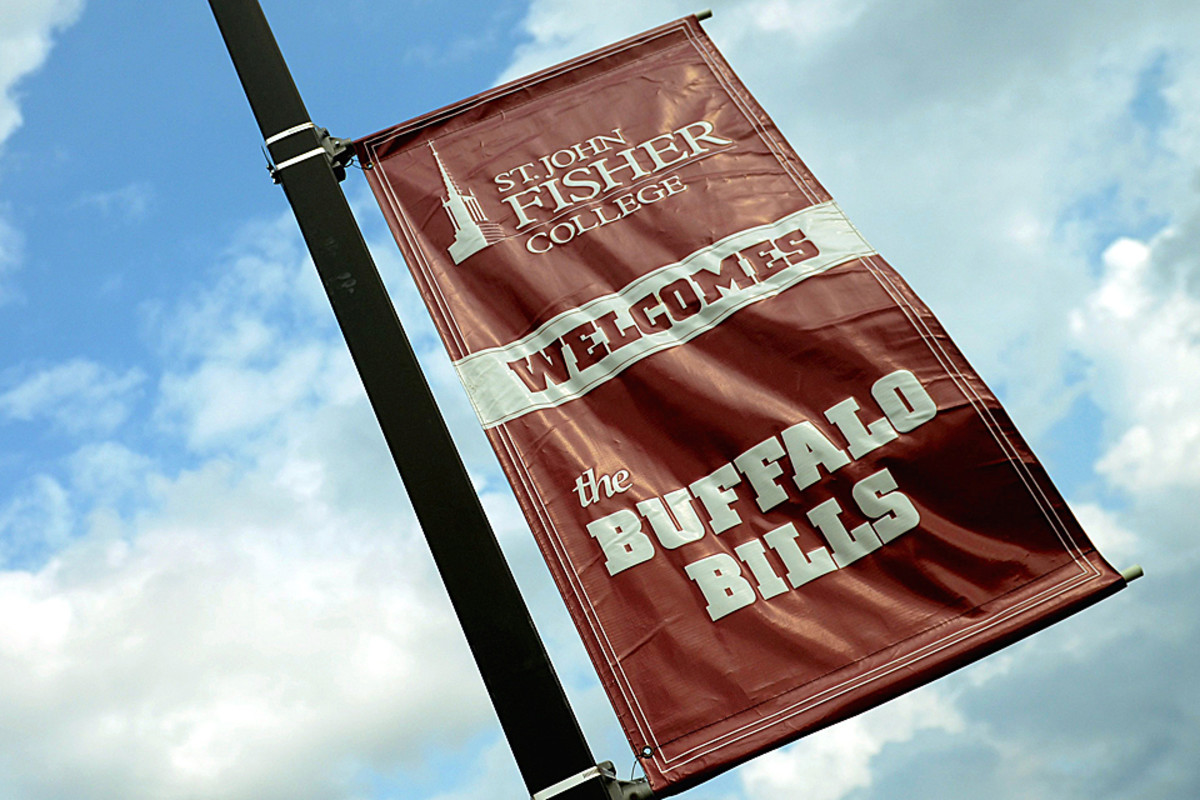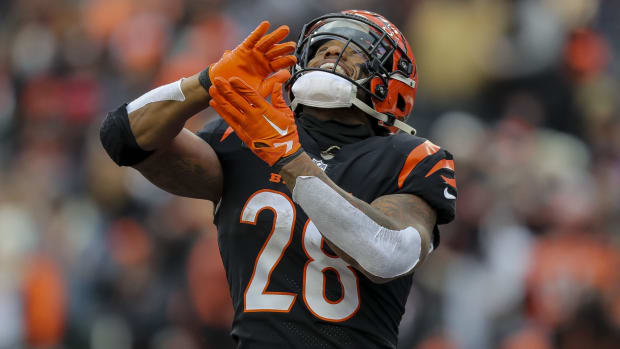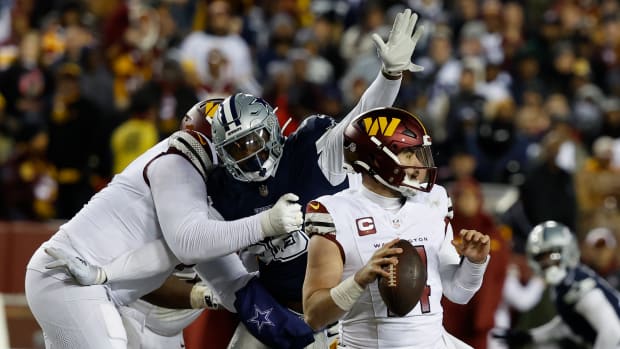Moving Day in Buffalo
PITTSFORD, N.Y. — The department bosses watch with a mix of resignation and amusement as the annual late-summer scramble begins in earnest. Two dozen interns descend on a pair of moving trucks parked back to back with the doors flung open, t-shirts and shoulder pads and athletic tape spilling out. This is the official end of summer break.
College juniors and seniors hailing from places like Pullman, Wash. and State College, Pa. are still wearing their school’s gear as they haul. Their Buffalo Bills apparel is in those boxes being handed down by tattooed movers on the campus of St. John Fisher College.
“I really don’t know how we would do this without them,” says an assistant athletic trainer.
The move to Pittsford takes four days, employing 10 to 12 men from Cook Moving Systems, several dozen Bills employees and 53 team interns. The haul includes 300 footballs (a rainy practice day can render up to 40 balls unusable by quarterback standards), 18 different types of facemasks, 260 terabytes of video data, 2,000 rolls of athletic tape and roughly 22,000 pounds worth of weight room equipment (the equivalent of two African elephants). Cook Moving Systems employees work 12-hour days and load up approximately 170,000 pounds of gear among 18 truckloads headed for suburban Rochester.
This year, just 14 NFL teams will pack up their team facility and move to a resort or small college campus for training camp. It’s a dying art; in 2000, just five teams held camp at home. Clubs stopped moving for many reasons, most often convenience. As franchises spent more and more money building and refining state-of-the-art practice facilities, and coaches fell out of love with that sleepaway-camp-team-bonding thing, the Bills and others fell into the minority.
Thus, The MMQB set out to answer the following questions: Why do the Bills do it? And how do they do it?
The search for reasons yields plenty of opinions, perhaps none more salient than that of general manager Doug Whaley, who inherited the tradition but believes in it all the same.
The key, Whaley says, is to make players uncomfortable.
“This game is about distractions, and dealing with distractions,” he says. “I think one of the really important things about getting away to camp is to see what it's like for a player and how he reacts when he's uncomfortable. When he’s in a dorm room, when he’s away from home, when it’s all football.
“Do you push through it trying to get better? Or do you tap out?”
The second reason, perhaps the one most often cited among Bills employees, is money. The town of Pittsford is home to just under 30,000 people, and the 154-acre campus of St. John Fisher College, alma mater of CEO Russ Brandon, has been the home of Bills training camp since 2000. The Bills estimate 18% percent of season-ticket sales come from the Rochester area.
With the potential of a new ownership group looming, and the franchise having missed the playoffs every year since 1999 (the longest streak in NFL), the Bills can’t afford to ignore ripe regional markets.
“It can be a pain, moving everything,” says equipment manager Jeff Mazurek, “but you see the reason for it. We want to reach those Rochester fans and Canadian fans, and we do a good job of it.”
* * *
Jeff Mazurek grew up a Bills fan in Western New York. Now he's the Bills' equipment manager. (Robert Klemko/The MMQB)
Everything goes.
That’s the way it’s been for a few years, and especially this season, with the Bills preparing for a five-game preseason and the earliest training camp start in the NFL. That means just about everything from the equipment room to the coaches’ offices will be mounted onto dollies, loaded into big white moving trucks and re-assembled 80 minutes northeast. The process becomes a spring-cleaning of sorts, with long-forgotten gear being pulled from closets and reconsidered for the haul. And that’s how I found it: The holy grail of obscure NFL memorabilia.
Any experienced office mover will tell you: The best time to go treasure hunting is moving day. I start at Ralph Wilson Stadium, where I navigate safely past construction workers welding support beams, husky interns half-jogging to and from trucks, and into the visitor’s locker room where the rookies made their home during minicamp.
And there they are: Terrell Owens’s custom Nikes. Red, black and metallic silver, they shine as bright as they must have during those halcyon days of 2009, when T.O. played for the Bills. It was a one-year stint on the back end of the wide receiver’s tremendous and, sometimes, troubled career, but the Bills kept over a dozen pairs of his size 14 Air Jordan cleats.
“That type of stuff,” explains Mazurek, “we keep just because it's cool. And sometimes the players want to wear them for practice. For the novelty.”
Mazurek’s equipment rooms, nestled deep inside Ralph Wilson Stadium, are the first to be emptied. For the first time all summer, he must skip his morning routine of loading 4-year-old twins and a 2-year-old son into his SUV and picking up coffee and donut holes at Tim Horton’s. During the 10 a.m. drive to camp, his wife calls to let him know his son woke up screaming and crying “Daddy!” at 7 a.m.
“I tried to let them know I wouldn’t be there starting today,” he says. “They probably won't even realize I'm gone by the end of the day.”
Mazurek is what you’d call a Bills lifer. He grew up outside of Buffalo in West Seneca. In 1994 he and his father attended Super Bowl XXVIII in Atlanta, the last of the Bills’ four consecutive Super Bowl losses. Mazurek interned as a ball boy in the summer of ’97, and got a job with the team shortly thereafter.
When the team’s equipment manager was fired in 2012 (Dave Hojnowski is currently suing the team, alleging age discrimination), Mazurek was elevated to equipment czar, putting him in charge of outfitting 90 players (with a constant eye on the weather) and 80 team employees.
He has a passion for pushing the envelope when it comes to fashion, occasionally bringing rebuke from the NFL’s uniform compliance observers. For instance, helmet visors featuring team logos are a no-no, even in preseason.
“Part of the fun is pushing what you can and can't do, as long as it's cool with Coach,” he says. “It's about pushing the brand. You want the players to be proud to wear the logo.”
Fred Jackson was looking good in a Bills logo visor, courtesy of Mazurek (via instagram.com/TheMMQB)
The job, like the move, has its hassles. Last year Nike shipped over 50 boxes of new apparel on moving day. Apparel sponsor reps direct their complaints to Mazurek when their brand isn’t visible in some local news feature filmed in the locker room. He and a staff of three assistants and six interns do player laundry until 12:30 a.m. during camp, and wake at 4 a.m. daily to fold three industrial dryer loads of towels.
“For these six weeks you just go through it,” he says. “After a couple weeks you hit a wall. But coach [Doug] Marrone, Doug Whaley and the ownership is so supportive. It's top notch how they treat us. I wouldn't be doing what I do if it wasn't that way.”
Mazurek arrived in Pittsford on day one to see the first trucks arrive and the first wave of interns—from athletic training, player development and equipment—help movers unload it. Athletic training has the most interns of any department with 11. Ever since Korey Stringer died of heatstroke during Vikings camp in 2001, the Bills have assigned four interns to regularly water the linemen during training camp. In addition to the 2,000 rolls of tape athletic trainers will use in Pittsford, they’ll tear through 3,000 plastic bags for ice packs and 10,000 bottles of Gatorade, roughly 250 a day.
Aside from coaches, no staff members spend more time with players than athletic trainers, making them among the most plugged-in employees on any team. They deal with athletes when they are injured and at their most vulnerable, and often live with the most secrets.
I ask Shone Gipson, assistant athletic trainer to Bud Carpenter, for his best Marshawn Lynch story (Lynch played here from 2007-10 before being traded to Seattle, swearing off the media and winning a Super Bowl).
“Stories you can print, or ones you can’t?” Gipson asks, tongue in cheek.
“One I can print.”
“Oh, I don’t have any of those.”
Actually, here’s one: When Lynch was navigating his controversial Super Bowl week in January, during which he declined to speak with almost all press, he learned of the death of Gipson’s father and called him to offer condolences.
“For him to do that, with everything he had going on,” Gipson said, “It meant a lot to me, and it showed a lot about who he is.”
Former players leave legacies behind in Pittsford, good, bad or otherwise. Owens left his mark (yet again) by being practically impossible to dress, prompting a camp tradition of a visiting seamstress who tightens waistlines and hems sleeves during the first week. The player with the largest legacy is, not coincidentally, the one who refuses to go away. Former quarterback Jim Kelly, in the midst of his second fight against cancer, hosted a one-day youth football clinic on campus during move-in week, despite having lost over 50 pounds since the reemergence of the disease.
During his playing career, the Bills met in Fredonia, N.Y. for a very different kind of training camp.
“It’s good to get away from what you’re used to every single day,” Kelly told me during a break at his clinic. “Our practices only lasted about an hour and 45 minutes. Guys would golf in between practices and we’d go have beers at night.”
Some 20 years later, with the urgency of perennial failure pressing on veterans and rookies alike, second-year quarterback E.J. Manuel will have a different experience.
“It’s work all night and day, and you’re always together,” says Bills running back Fred Jackson. “It’s something that can contribute to E.J. being a leader, being around the guys and them seeing that he has those leadership qualities. Hopefully he can come out and show it.”
* * *
Interns relax in what will be the camp's trainer's room. (Robert Klemko/The MMQB)
On the second day of the move, as Kelly finished his clinic, the video crew assembled 50-inch flat screen televisions and meeting-room laptops with projectors. Marrone simplified their jobs last season when he brought all of the coaches’ offices out of individual rooms. It’s now a wide-open common area with meeting rooms for the offense, defense and special teams and a cordoned-off space for him, Whaley and Brandon. (The executive meeting space was open a year ago, but a dividing wall was installed for 2014.)
That means most of those terabytes, which live in chest-high servers (the hardware necessary to house 40 terabytes costs about $35,000), flows into one room where the Bills’ brain trust plots the 2014 season.
For all the expensive equipment they’re responsible for, the video guys take an equal amount of care in the small things. They install an extra projector for the team meeting room even though it’s already outfitted with a similar one, simply because coaches get frustrated if they have to learn a new remote. They outfit an assistant coach’s desk with a wireless keyboard and mouse because that’s how he prefers it back in Orchard Park. They pack color-coded mini Nerf balls with the insides cut out. It’s the best receptacle, as far as they know, for data cards that must be dropped from 50-foot lifts and converted into viewable film minutes after practice is over.
Video director Greg Estes once invented a bubble wrap sleeve for the same purpose back in the VHS days, when the necessary video accessories took up twice as much space as the current servers and once killed power to an entire dorm while the team was setting it up.
More From Bills Training Camp
Check our Buffalo Bills Training Camp hub for more stories from Pittsford, including Peter King's thoughts after watching a practice.
What we call analytics today was in its infancy then; tendencies were charted by hand and reports focused on the basics. Today a coach can ask Estes for a reel showing the first play of every offensive series during an opponent’s season. The video crew can also deliver a self scouting report that tells Marrone what plays he calls the most on third down when trailing in the opponent’s red zone, useful info for coaches interested in breaking bad habits.
Estes has seen both analytical-minded and shoot-from-the-hip head coaches, and places Marrone somewhere in the middle.
“He doesn't kill people with stats, but he knows them,” Estes says. “You see guys swing back and forth between This is what we do no matter what, and over-analyzing. He was steady all season. He's more aware of the tendencies than most.”
As Estes and company finished their setup in Pittsford and settled into dorm rooms with bare desks and twin beds pushed together, back in Orchard Park the strength and conditioning staff prepared for the first players to report. Rookies, new veterans and quarterbacks participated in conditioning drills on day three of the move to get a head start on camp.
Not among them was Pro Bowl defensive tackle Marcell Dareus, who would show up at camp days later, out of shape and unable to pass the conditioning test after a troubling offseason. The man tasked with getting Dareus and other strays back in shape is strength and conditioning assistant Dan Liburd, otherwise known as The Most Interesting Man in the Building.
Liburd is a 5-8, 175-pound triathlete, bodybuilder and power lifter. The Long Island native, in his sixth year with the Bills, oversees team nutrition. He’s well known among Bills employees for being the face of a cafeteria video loop, showing smartphone video of him offering exuberant words of advice to rookies touring a grocery store. Back at the facility, Liburd posts competition photos of himself lathered in spray tan on a bulletin board as a means of establishing ethos.
“I try to draw interest rather than just being a resource,” he says. “I want to be aggressive about it.”
Dan Liburd, setting up the weight room, will work to keep players' nutrition and fitness on track during camp. (Robert Klemko/The MMQB)
After helping run newcomers and QBs through drills, Liburd makes the drive to sunny Pittsford to help organize the arriving weight room equipment. Over the years, the Bills have left platforms and other equipment at St. John Fisher for the school’s Division III football program to use. Much of it is up to par with Buffalo’s current facilities.
Nearly every day during camp, Liburd and colleagues will wake at 4 a.m. for 4:30 workouts and work until a staff meeting breaks around 9 p.m. That’s when Liburd, 29, rushes to the cafeteria to sit just around the corner from the pizza stand, hoping to catch a lineman in the act. Some players will sheepishly put the pizza back upon seeing Liburd. Others will claim it’s for a friend. Some say they deserve a break and ignore him.
“The nutrition gap,” as he calls it, can be very wide. You have guys who love it, like Kiko Alonso, and guys who don’t understand it.
“In 2011, we had a guy who had issues with cramping and we discovered his carb consumption was incredibly low. We said What are some carbs you enjoy? And he had no idea what carbs were.”
Therein lies one clear advantage of training camp away from home; the staff has 24/7 access to players, breaking bad habits whenever possible. But Liburd sees a deeper, psychological reason for camp in Pittsford. And it’s the best I’ve heard all week.
“I love it simply for breaking up the monotony,” he says. “It's great to break camp and start this new phase. When you come back there's a new focus on the season.”
But that day is six weeks away. Before the Bills can even think about the regular season, there are a couple of elephants that must be cajoled into place. The movers huff and grunt with the strength and conditioning staff as the machines are placed just so.
The interns are nowhere to be found when the last big items are delivered from Orchard Park. From here on out, it’s a job for professionals.










































